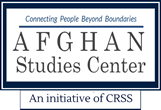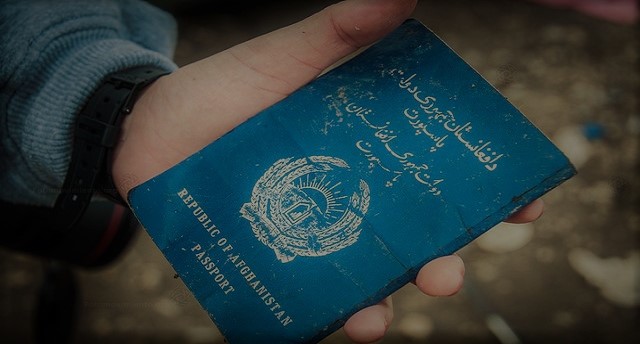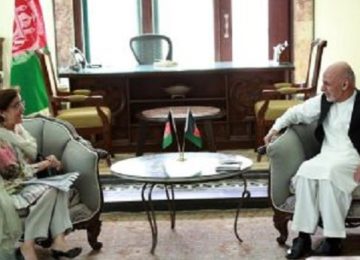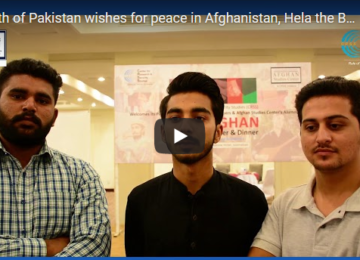In a recent television appearance, the Turkish Interior Minister, Suleyman Soylu, said that 15,000 Afghans have been sent back home from Turkey. While it is likely that this number has been exaggerated, there is no doubt that in April and May of 2018, thousands of Afghan migrants were sent back on charter flights from Turkey to Kabul. This is the Turkish government’s response after a 400 per cent increase in arrivals of Afghan migrants to Turkey during the first quarter of 2018. In early April of this year, the first charter flight carrying Afghans back to Kabul flew out of Erzurum, a city in eastern Anatolia that has become the centre of these returns. AAN’s guest author Amy Pitonak visited Erzurum to find out first-hand about the situation for Afghans there.
Afghans make up the second largest group of protection seekers in Turkey, totalling around 157,010 people. The largest displaced group remains Syrians who number approximately 3.5 million. However, they are classed under the ‘temporary protection regime’, rather than the “international protection regime” which encompasses all non-Syrian protection seekers. This number of Afghan protection seekers consists only of those who have managed to register in Turkey and maintain that status throughout their stay. It is likely that there are thousands more Afghans in Turkey who do not fall into the category of protection seekers (1). The Turkish Directorate General of Migration Management says 46,495 undocumented Afghan migrants have been apprehended between 1 January 2018 and early June 2018. Although this count does not specify how many of these are new arrivals, it is slightly more than the 45,259 migrants for the entire year of 2017 (for more detailed statistics on undocumented migration into Turkey, see here). The province of Erzurum in northeast Turkey has seen particularly levels of Afghan transit migration, given its locational on the migration routes to Western Turkey. The HurriyetDaily News has quoted government officials saying that over 20,000 undocumented Afghan migrants crossed through Erzurum in the first three months of 2018.
In April 2018, the Turkish government increased its efforts to stem Afghan migration across the Iranian border. These efforts began in Erzurum during the first week of April, after a group of Afghan officials arrived, at the Turkish government’s behest, having agreed to provide travel documents to Afghans detained in Erzurum’s removal centres so that they could be returned to Afghanistan. In previous years the Afghan government had been unwilling to readily provide such documents (see here). This visit only concerned the removal centres in Erzurum, although, judging by later deportations from other provinces, it is likely that the question of travel documents was raised in these locations as well. While removal efforts have spanned the whole of Turkey, Erzurum has witnessed the largest number of Afghans deported. Charter flights out of Erzurum have brought approximately 2,334 people back to Afghanistan (2).
The arrival of the Afghan officials to Erzurum was followed by high-level bilateral visits between Turkey and Afghanistan. On 8 April 2018, the Turkish Prime Minister Binali Yıldırım said, during a joint-press conference with the Afghan Chief Executive, Adbullah Abdullah, that the two countries “have reached an agreement on the matter of sending back those who arrive illegally.” (see here). However, there does not appear to be a formal readmission agreement between the two countries, and the Afghan government themselves seem conflicted as to what the agreement entails, or if any agreement exists at all. Hafiz Ahmad Mikhail, the media adviser for the Afghan Ministry of Refugees and Repatriation, has said that his ministry had not been consulted about the deportations, and that no such agreement had been reached with Turkey (see here, condensed English version here).
This dispatch aims to examine the conditions in Erzurum given its importance as a place of transit, detention, and now deportation of Afghan migrants. It will then examine the deportations of Afghans on a national level, the laws surrounding detention and deportation in Turkey, and the possible motivations for the Turkish government’s sudden and widely publicised deportation initiative.
Reaching Erzurum
Erzurum has been a city of migration and transit for over a millennium. Located 2,000 meters above sea level on the Palandöken Mountains, it was a major stopping point for voyagers traveling from Iran to Western Anatolia on the Silk Road (3). In modern times, it has become a point of transit for Afghans who have crossed into Turkey from Iran. Erzurum’s authorities largely tolerated this movement, up until March of 2018.
In order to reach Turkey, most Afghans cross over from Iran by foot. It is the final stretch of a journey that spans Afghanistan, sometimes Pakistan, and Iran into Turkey, with Europe as the preferred final destination. Afghans coming into Turkey from Iran most often cross into Iğdır, Ağrı, or Van provinces and, to a lesser extent, the eastern portion of Hakkari province. It is often in these provinces that they meet up with smugglers who will take them further into Turkey. The district of Doğubeyazit in Ağrı, which sits on the Gürbulak border gate with Iran, is a known hotspot for smugglers, not only of migrants, but also cigarettes and narcotics. There are claims that Iranian border guards make no attempts to prevent undocumented migration into Turkey, with one Afghan migrant telling Turkey’s state-run Anadolu news agency that an Iranian border guard let up to 500 migrants pass in one night (see here). From these provinces, many continue approximately 300 kilometres westward into Erzurum (4). Those who are unable to find smugglers to take them by vehicle, or who are abandoned by smugglers early on in their journey, must walk.
The head of the Erzurum Development Foundation, Erdal Güzel, says that these flows into Erzurum started in 2010 and 2011. They were initially composed almost exclusively of Afghan and Iranian migrants. Over the past few months, there has been a dramatic increase in the number of Afghan arrivals, alongside Pakistanis and Bangladeshis, who had not previously been seen in large numbers. The Human Rights Association of Turkey identified most of the Afghans crossing through Erzurum in 2018 as young men between the ages of 12-25. However, there are also families and much more rarely, single women.
Güzel offers four explanations for this increase in arrivals: the end of a harsh winter in Turkey’s northeast, where temperatures reached minus 21.3 degrees Celsius in Erzurum this year; Erzurum’s reputation for having locals who are friendly towards migrants; authorities who were, until recently, willing to allow transit migrants to continue on their way;and, perhaps most importantly, a desire to enter Turkey before a 144 kilometre border wall with Iran is completed that spans the Turkish provinces of Ağrı and Iğdır. The Minister of the Interior said in May that the Iğdır portion of the wall is almost finished, with the Ağrı section 50% completed, and projected due to be finished by September 2018.
The instability of Turkey’s migration policies also has created a perception amongst potential migrants that Turkey is a safe transit country. Many of them saw the Turkish President, Recep Tayyip Erdoğan’s speeches, in which he said refugees were welcome in his country, or heard from family and friends that local authorities had a capture-and-release approach to undocumented migrants. This has led to some migrants coming to Turkey with high expectations, only to have those expectations shattered if they are arrested and told they have the choice of remaining in detention or being sent back. This disappointment is amplified by the fact that many pay large amounts of money to get into Turkey from Iran. A report by the Erzurum branch of the Human Rights Association of Turkey (IHD) placed the amount paid between 800 and 1,100 euros.
Erzurum also houses its own population of Afghan residents. The estimates vary widely regarding their numbers. Güzel, head of the Erzurum Development Foundation, places their number at around 400 families. The Erzurum IHD’s migration commission gave a higher estimate of around 750 families. Güzel says that many of the Afghans currently residing in Erzurum were those who arrived in prior years and did not have enough money to continue their journey onward to Europe, and who choose instead to apply for international protection. They became used to living in Erzurum, and started learning the language and sending their children to school. Güzel says that the cultural similarities between Afghans and locals help in their integration, saying that the local population comprises largely conservative Muslims who feel it is their duty to accept refugees.
In Erzurum, where international organisations have less of a presence than in larger cities, local civil society groups, such as Ebru Ishak and the Erzurum Development Foundation, work to provide protection seekers with food, medicine and clothing (5). However, these civil society groups are forced to centre their work around Erzurum’s long-term population of Afghan migrants. In previous years, the Erzurum Development Foundation and Ebru Ishak were able to provide support for Afghans who were simply passing through, but now the demand has greatly exceeded their capacity. A member of the Erzurum IHD’s migration commission also says that, while these groups are doing their best to provide for Afghan migrants in the province, they are unable to fully address their socio-economic difficulties. The fact that there is no large-scale and comprehensive aid mechanism, paired with the migrants’ lack of knowledge of available resources and rights, means that living conditions remain difficult for a large number of Afghans, who often live in shanty-houses outside of the city.
Removal Centres and Deportations
Erzurum has two removal centres, or centres for foreigners placed under administrative detention, located in Aşkale. This is a small district with a population of around 22,000 people located an hour away from the city centre. Each centre has a capacity of 750 people, making them the largest in Turkey. Despite their size, they were so overcrowded this year that detainees had to be housed in gyms. The creation of these two centres was funded through the EU’s pre-accession funding (IPA funds). Construction began in 2011 and the centre became operational in 2015 (see here). These funds also contributed to the construction of centres in five other cities (6).
Prior to April 2018, Erzurum’s removal centres were rather arbitrary in how they dealt with undocumented migrants. While some were released within days to other cities, others were held for months on end, with no indication of when they would be released. However, starting in March until mid-May, no undocumented single Afghan migrant caught in Erzurum was allowed to go free. Single Afghan women have been treated the same as single men. Families, minors and pregnant women are allowed to go to other satellite cities in Turkey, largely of their choosing, or special accommodation centres in the case of unaccompanied minors with no relatives in Turkey.
In previous years, human rights groups have issued numerous reports highlighting human rights abuses at Aşkale. A joint report from 2016 by the Turkish migrant rights organisation, Mülteci-Der,andthe German ProAsylum organisation quoted a migrant who described the centre as: ” [Erzurum centre] was really difficult. The treatment was really bad. The conditions too…” (see here). In 2016, the Turkish Bar Association’s Human Rights Centre published a report in which they detailed instances of violence within the Aşkale centre, including severe beatings during an incident of detainee unrest, and the suspicious death of a Syrian detainee. Both these incidents occurred in 2015 (see full report here). An Amnesty International report in 2015, and an Asylum Information Database (AIDA) report from 2017 (please see here and here) document detainees having restricted access to lawyers, and an inability to contact their families. Güzel, of the Erzurum Development Foundation, points to overcrowding as the main source of problems inside the removal centres. Çorbatır agreed “as counts rise, so do the problems”. However, Çorbatır also added that, while conditions in the centres have improved over the past few years, these improvements provide only half of what is necessary. While European countries are keen to provide material support, there is also a need for personnel training and monitoring mechanisms. However, AAN inquiries found that the 2018 situation in the Erzurum centre has not improved for Afghans, with verbal and physical abuse being reported.
Often, Afghans who had stayed in the Erzurum centre for months on end had requested to be sent back. However, the Afghan government initially refused to provide travel documents for them, requesting proof that they actually wanted to be sent back. The matter of travel documents was resolved after an Afghan delegation visited Erzurum in early April 2018, and agreed to provide travel documents more readily. Several sources, including the Association for Solidarity with Asylum Seekers and Migrants (ASAM), say that the Afghan consulate continues to confirm that every Afghan sent back from Turkey did indeed request to return before providing travel documentation. According to ASAM, those who refuse are now sent to the Düziçi camp, in the Southern province of Osmaniye, where they are held while awaiting further developments on their case.
According to Turkish law, individuals cannot be held in removal centres longer than a year. They are not always informed of this fact while in detention. Others may not be aware that they can apply for asylum through the UNHCR and its local implementing partner, the Association for Solidarity with Asylum-seekers and Migrants (ASAM). ASAM says that it informs the detainees who are able to make contact with them of their ability to apply for international protection from within the removal centre. It also notifies them of their right to appeal their detention and assists them in requesting legal aid in this matter. However, many Afghans may not even be aware of the existence of ASAM. Also, there is no set mechanism in place that would ensure that detainees are able to consult with them.
Amnesty International, in its urgent appeal from April 2018, reported that Afghans in the Düziçicamp had been coerced into signing return documents that are only in Turkish. There have also been cases of coerced signing of the return documents from the removal centres at Erzurum. In regards to return documents only being provided in Turkish, migration professionals in Turkey who AAN spoke to said that this was not the case in Erzurum, and did not see why it would occur in other camps. They described the standard operating procedure as providing documents in whichever language (usually Dari or Pashto) is spoken by the signatory, alongside a translator who reads the forms out loud. The Afghan government’s statement also corresponds to this. The Afghan Consul General in Istanbul, Zakaria Barakzai,said that the documents given to the Afghans were in Pashto, Dari and English. He emphasized that all returns were voluntary, saying that Amnesty’s report “does not reflect reality” (see here).
It is likely that, due to the signing of these forms, the Turkish government is able to classify and qualify these returns as ‘voluntary’. However, given the conditions in the centre, and detainee’s lack of information regarding their rights, it is questionable how ‘voluntary’ these returns actually are. Hafiz Ahmed Mikhail, the media adviser for the Afghan Ministry of Refugees and Repatriation, echoed this sentiment, said “They have apparently signed papers for a voluntary return, but they were kept in camps where the situation pushed them to choose to come home” (see here). Ali Hekmet, the chairman of an Afghan refugee rights association in Turkey, said in an interview in April with Deutsche Welle that he did not believe the cases of the first wave of deportees had been examined, considering the size and speed of the deportations (see here).
Although the largest numbers of deportations were carried out from Erzurum, this location is not the only city from which Afghans have been deported. Based on announcements from the Directorate General of Migration Management on their official twitter account and to the press during April and May 2018, 1,326 Afghans were deported from the provinces of Ağrı, Izmir and Gaziantep (7),in addition to the 2,334 deported from Erzurum. Batman’s Provincial General of Migration Management also has said that 500 Afghans had been deported from there during the period from November 2017 to the end of April 2018, although it was not specified whether any of these deportations were framed under the Turkish government’s most recent initiative. The IOM records 1,142 Afghans being returned from Turkey through its Assisted Voluntary Return Program during the period 1 January 2018 to 2 June 2018, and said that it is not handling the caseload of the thousands of other Afghan deportees. However, it is unclear as to whether the Turkish authorities are including this number in their count.
Operations targeting undocumented migrants are also being carried out in provinces across Turkey. Operations in provinces that are considered to be ‘gateways’ to Europe tend to be large-scale sweeps in which undocumented Afghans are caught up alongside many other nationalities (such as an operation in Edirne that apprehended 571 people, see here). Others, such as a raid in Istanbul’s Beykoz district, which has been dubbed a “market for Afghan workers”, seem to be particularly focused on Afghans (see here). Several Afghans in Istanbul’s Zeytinburnu district, which also has a large population of Afghan immigrants, told AAN that police had been performing checks at workplaces, and asking Afghan workers to sign documents, give their fingerprints, and have their photos taken.
It is quite possible that the volume of returns in April and May 2018 has been exaggerated. The IOM in Afghanistan did not confirm the official number of 6,800 given by the Turkish government for the first week of the deportations in April. The total number of people deported, based on announcements by the Directorate General of Migration Management (3,670) is also far below the number given by the Ministry of the Interior. Moreover, while Turkey’s Migration Administration was quite public with its deportations during April and the beginning of May, reports of 50-60 Afghans being released from the Aşkaleremoval centrein mid-May may be a sign that Erzurum’s migration authorities are resuming their old practices of releasing undocumented migrants to other cities.
While this wave of deportations appears to be the largest, and most heavily publicised, it should be also noted that Turkey has been apprehending and deporting undocumented Afghan migrants for years. A notable example of this is Amnesty International’s report that 30 Afghan asylum seekers were sent back to Afghanistan directly after the signing of the EU-Turkey deal (see here). However, there are countless reports in Turkish media of undocumented Afghan migrants being arrested in previous years. These articles generally stated that the apprehended migrants “will be” deported. Since there is no effective monitoring system in place, there is no way of knowing whether the deportation procedures were actually carried out for these individuals.
Legal and Policy Framework
Due to Turkey’s application of the geographical limitation to the 1951 Geneva Convention, which stipulates that only those fleeing from “events occurring in Europe” can become refugees, protection seekers from non-European countries cannot be classified as refugees per se (see this AAN analysis here). Rather, they are classed under conditional forms of protection. While Syrians are classified under a separate “temporary protection” regime, other nationalities who are unable to return to their home country due to a fear of persecution, indiscriminate violence, torture, or other degrading treatment have the right to apply for ‘international protection status’. This status grants one the right to stay in Turkey, while awaiting transfer to a third country. This wait can take years, and those who cannot find a third country willing to take them may end up staying in Turkey indefinitely, with no right to residence status beyond that of international protection. Third country resettlements for Afghan protection seekers are decreasing: in 2016, 495 Afghans were resettled from Turkey, while in 2017, that number dropped to 213 Afghans. For both years, the US and the UK were the only two countries to take in Afghan protection seekers from Turkey. For the first quarter of 2018, 27 Afghans were resettled; 23 to the US and four to Canada.
Despite Turkey’s application of the geographical limitation, the principle of non-refoulement is still recognized in Turkish law. Article 4 of Turkey’s Law No. 6458 on Foreigners and International Protection (LFIP) states that no one “shall be returned to a place where he or she may be subjected to torture, inhuman or degrading punishment or treatment or, where his/her life or freedom would be threatened on account of his/her race, religion, nationality, membership of a particular social group or political opinion.” Article 63 of this law also states that those facing serious threat owning to violence or conflict in their country may avail themselves of subsidiary protection. Applicants or beneficiaries of international protection are not to be subjected to removal decisions unless they are found to be a threat to national security, or are convicted for an offense against public order. Moreover, the cases of all foreigners subject to removal proceedings must be examined individually to determine whether or not they meet the criteria for international protection prior to deportation, as per Article 4(2) of the Implementation Regulation of the LFIP. Judging by the size and speed of Turkey’s deportations of Afghan migrants, numbering at the very least 3,670 between 8 April and 5 May 2018, it is doubtful that Turkish authorities were able to comprehensively examine the files of all deportees.
In relation to detention, Article 57 (2) of the LFIP states that foreigners subject to a removal decision may be placed in administrative detention if they are a flight risk, have breached entry or exit rules, have used fake documents, have not left Turkey, and/or pose a security or health threat. The case of those in administrative detention is to be reviewed regularly, and is to be immediately suspended if no longer necessary. Administrative detention can be extended for a maximum length of one year, and detained foreigners have the right to appeal, with free legal counsel to be provided for those unable to pay for an attorney. However, Article 96(7) of the Implementation Regulation on the LFIP states that those who apply for international protection while already in administrative detention will continue to be detained on the basis of Article 57. (8) Since the decisions regarding whether or not to place and keep a foreigner in detention is largely up to the discretion of a province’s migration authority, the application of the laws governing detention varies between provinces, and even amongst implementing officials, as evidenced by the uneven application of detention procedures in Erzurum.
Turkey has no formal readmission agreement with Afghanistan, such as those that Turkey has entered into with Ukraine, Nigeria, and several other countries. During his visit to Afghanistan on 8 April 2018, following the arrival of a delegation of Afghan officials to Erzurum, the Turkish Prime Minister, Binali Yıldırım, emphasized that Turkey and Afghanistan’s cooperation in regards to the question of refugees was nothing new as it dated back to 2015 and even before. Indeed, Turkey and Afghanistan signed the ‘Strategic Cooperation and Friendship’ agreement in October of 2014, whose second article on security mentions cooperation in the areas of undocumented migration and border control (see full text of agreement here). Thus, the ‘agreement’ that Yıldırımannounced as having reached with Afghanistanmay simply be applying the second article of the 2014 agreement with renewed vigour. It is also possible that Yıldırım was referring to the proposal of a readmission agreement, rather than a signature; the EU’s Turkey Report, dated April 17th 2018, says that a draft proposal for a readmission agreement had been submitted to Afghanistan, but Turkey was still awaiting a response.
Motivations behind the Returns
Given the clarity of Turkey’s laws against refoulement, one may wonder why the Turkish government, who often touts its treatment of migrants as more humanitarian than that of the West, would be so vocal about mass deportations to one of the world’s most conflict stricken countries. There are three possible answers to this: the sudden media storm surrounding the arrival of Afghans from Iran; the upcoming elections on 24 June 2018; and, a desire to extract more funding from the EU.
The outcry in the media over the arrival of Afghan migrants may have pushed the Turkish government to show it was taking action on the issue. After a widely circulated article by CNN Turk published on 30 March 2018 quoted Erdal Güzel, of the Erzurum Development Foundation, as saying that “1.5 million people were waiting to enter Turkey”, media reactions to Afghan migrants in Turkey blossomed into hysteria. Articles emerged qualifying Afghan migration into the country as a “great danger”, as “waves” coming into the country, and as an “explosion of illegal migration”. While Güzel stood by this 1.5 million number in his conversations with me, he did say that the subsequent reporting on it was over-the-top. However, Selin Unal, the UNHCR’s Turkey spokesperson, said that this number could not be confirmed.
The snap elections for 24 June 2018, called on 18 April may also have contributed to the return decisions. It is likely that the current government, led by the Justice and Development Party (AKP) wished to show itself as tough on migration prior to these elections amidst a domestic atmosphere that is increasingly hostile to migration, and an opposition that has often criticized the AKP for its “soft” migration policies. Three days prior to Prime Minister Yıldırım’s visit to Afghanistan, an MP for the main opposition Republican People’s Party, Fikri Sağlar, spoke in parliament on the dangers of the AKP’s open-door policy towards refugees, adding that the public needed to be informed of the mechanisms behind the Erzurum Migration Administration’s policy of giving Afghan migrants travel documents and sending them to other provinces. The Iyi party, another opposition party seen as being able to attract votes away from the AKP, has also made combatting undocumented migration part of its election platform. It is likely that the current government feared that any inaction on the issue of undocumented Afghan migration would provide easy fodder for the opposition, and decided to take drastic, and public, measures. Undocumented migration features heavily in the AKP’s election manifesto, including mention of plans for a “national voluntary return mechanism”.
The deportations may also be a way for Turkey to pressure the EU for more funding to combat undocumented migration. Interior Minister Soylu addressed Europe in a recent speech, pointing out that migration from Turkey to Greece had fell from 8,500 a day to 61, and saying “If you want, we can open the doors….we are doing you a favour-acknowledge it” (see here). In their speeches, Turkish officials have also exaggerated the increase in Afghan migration, possibly in an attempt to magnify the perceived effects of the deportations. European countries have not shied away from providing Turkey with aid to prevent undocumented migrants from reaching their borders. Projects that were recorded as ongoing at the end of 2017 included 60 million Euros in IPA funds to meet the needs of returnees to Turkey under the EU-Turkey deal and other undocumented migrants apprehended in Turkey. The UK also allotted around 1,3 million pounds for projects relating to voluntary returns, combatting undocumented migration, and maintaining removal centres. The mass return of Afghans demonstrates that Turkey is putting these funds to use, while also implying that a new wave of migrants could reach Europe if the funding is cut (for in-depth analyses on Afghan migration to Europe see this AAN thematic dossier) .
‘Voluntary returns’ as an effective deterrent?
The Afghan and Turkish governments’ lack of transparency on return procedures, number of returnees, and existence of an agreement makes independent monitoring of the situation nearly impossible. This lack of transparency also enables the arbitrary application of Turkish laws on detention and deportation. Obscuring the return mechanism and number of returnees may be intentional, as it provides the Turkish government with a means of touting its number of returns to a domestic audience, but without facing possible repercussions for unlawful deportations, while also enabling the Afghan government to avoid domestic and international condemnation for facilitating these returns.
The European Union also should reconsider funding removal centres that have questionable human rights records, as they are potentially sending people who meet the criteria for protection status back to danger. Several Turkish migration researchers and humanitarian workers told AAN that these returns implicitly suit the EU’s interests by preventing Afghan migrants from reaching Europe via land and sea routes from Western Turkey. Humanitarian workers in Erzurum also questioned why a community in one of Turkey’s poorest regions was expected to accommodate thousands of Afghan migrants with what they perceive as limited support in terms of aid from the EU, when the EU is unwilling to resettle even a portion of these migrants on its own territory.
Erdal Güzel says that no matter what measures are put into place, Afghans will still find a way to come to Turkey, considering the immeasurable risks they have already proven willing to take. Deportees on one of the flights from Erzurum seemed to confirm this, telling reporters that “We will return, either illegally or with a passport.” (see here). If this is proven to be true, it is likely that Erzurum will remain a point of transit, and sometimes refuge, for Afghans who cross into Turkey from the Iranian border. In his pamphlet The Fall of Kars, Karl Marx wrote that Erzurum is the key to Istanbul. It appears that recent developments are giving a new meaning to this statement; we might now say that that Erzurum is the key to Europe as well.
(1) One member of parliament from the main opposition Republican People’s Party (CHP) has said that there are approximately 200,000 Afghans living in Istanbul alone, while Yaşar Yıldız, President of the Afghan Turk Foundation, places the total number of Afghans in Turkey at close to 450,000.
(2) Not all of the people on these flights were detained in Erzurum; detainees from Ağrıand Van were also brought to Erzurum in order to be deported, as Erzurum’s airport is bigger.
(3) Erzurum was also a strategic city during the Russian-Ottoman wars, which, themselves, created major population movements to and from the region. It also witnessed a massive exodus of Armenians in 1915-1916 during what most of the international community calls the Armenian genocide, but which locals insist was a period of mutual violence.
(4) While Erzurum is the primary point of transit for those crossing from Ağrı and Iğdır, some may travel through the Black Sea provinces. Afghans crossing through from Van also frequently cross through Erzurum. However, others have continued on the Muş-Bitlis highway further south. Those who crossed through from Hakkari may travel northward towards Van before going west, or far more rarely, continue traveling through Turkey’s southern provinces.
(5) Ebru Ishak, which provides daily hot meals, as well as a supply of dry goods and bread, feeds around 600 people a day, the majority of them Afghan and Iranian migrants. They provide food at a centre for under-age migrants in Erzurum, which houses around 200 people. The Erzurum Development Foundation also provides basic goods to migrants in need. It is also trying to expand its efforts to get young protection seekers into university, and is currently providing university test preparation to a group of Afghan students.
(6) The other centres built with EU funding are in Gaziantep, Van, Kayseri, Izmir, and Kırklareli.Although six of the seven centres were meant to be ‘reception’ rather than ‘removal’ centres, Metin Çorbatır of IGAM, an independent research centre focusing on migration and asylum in Turkey, says that all seven have been turned into removal centres now. There are a total of 18 removal centres in Turkey, with a total capacity of 8,276 people, alongside the Düziçi container camp, which has a capacity of 4,000 and is now being used as a removal centre. There are also plans to build another removal centre atIğdıraimed at stemming Afghan migration flows. The Aşkaleremoval centres’ operations are currently funded through a combination of EU funds, and funds from individual countries, such as Holland, or the UK, some of which are channelled through the IOM as funds for “capacity building”.
(7) In April 2018, 227 Afghans were deported from Ağrı, and 324 from Izmir; in May, 324 Afghans were deported from Izmir, and 451 from Gaziantep.
(8) Rather than the Article 68 of the LFIP, which states that international protection applicants are not to be placed in detention except under exceptional circumstances, and this is not to exceed thirty days.
By Special Arrangement with AAN. Original link.
Disclaimer: Views expressed on this blog are not necessarily endorsed or supported by the Center for Research and Security Studies, Islamabad.







